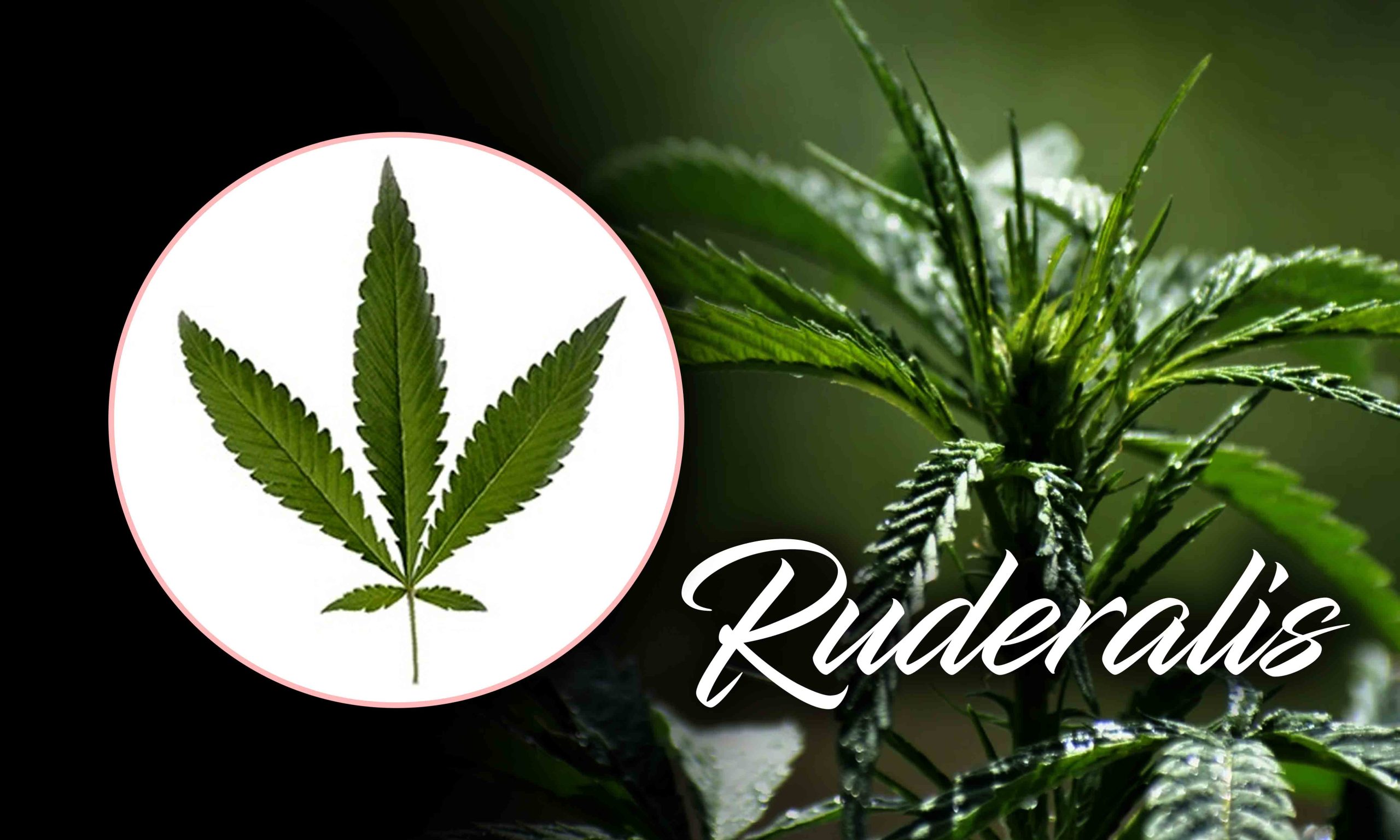Ruderalis genetics are often incorporated into breeding programs to create autoflowering hybrids. Some Ruderalis-derived hybrids have been developed specifically for their medicinal properties. Ruderalis is less famous than Sativa and Indica, but still holds interest as a member of the cannabis family. Despite being less talked about, this tough plant has special traits that make it useful in cannabis growing and breeding.
What Is Ruderalis
Ruderalis, referred to as Cannabis Ruderalis, is one of the three primary species of cannabis, alongside Sativa and Indica. Its name is derived from the Latin word “rudera,” meaning “rubble” or “rubble-dweller,” reflecting its ability to thrive in harsh, unforgiving environments. Cannabis Ruderalis comes from tough places like Siberia, Central Asia, and Eastern Europe. It’s tough enough to live in areas with short growing times and harsh weather. Its small stature, reaching heights of 1 to 2.5 feet, allows it to thrive in confined spaces and discreet outdoor locations.
Cannabis ruderalis strains differs from Sativa and Indica because it doesn’t need specific light changes to start flowering. Instead, it flowers automatically as it gets older, which is handy for growing outdoors in places with unpredictable weather. This quality has also made Ruderalis important for breeding new strains that flower on their own, creating top-notch autoflowering varieties.
Ruderalis’ Cannabinoid Profile and Effects
While Ruderalis is not typically sought after for its psychoactive properties, it does contain cannabinoids such as THC and CBD, albeit in lower concentrations compared to Sativa and Indica varieties. Its cannabinoid profile tends to lean towards higher levels of CBD, making it appealing for medicinal purposes such as pain relief, anxiety management, and inflammation reduction.
Due to its milder psychoactive effects and shorter stature, Ruderalis is often overlooked by recreational users in favor of more potent Sativa and Indica strains. However, its unique cannabinoid profile and autoflowering trait have garnered attention from breeders seeking to develop innovative hybrids with enhanced medicinal benefits and easier cultivation requirements.
Cultivation and Breeding
Cultivating Ruderalis is straightforward, thanks to its resilience and adaptability to various growing conditions. It thrives in both indoor and outdoor settings, making it accessible to growers with limited space or experience. The fact that it flowers automatically means you don’t have to stick to specific light timings, giving you more freedom when growing.
Ruderalis is important for creating new types of cannabis through breeding. By mixing Ruderalis with strong Sativa and Indica strains, breeders make hybrids with better features like autoflowering ability, stronger effects, and resilience. These hybrids suit different tastes and grow well in various conditions..
Sativa, Indica & Ruderalis
Sativa, Indica, and Ruderalis are three distinct subspecies of cannabis, each with unique characteristics:
Sativa
- Origin: Equatorial regions, including parts of Africa, Southeast Asia, and Central America.
- Appearance: Tall and lanky plants with thin leaves and long branches.
- Effects: Typically associated with uplifting, cerebral effects that stimulate creativity and energy. Often used during the day.
- Flowering Time: Longer flowering periods, usually 10-16 weeks.
- Usage: Preferred by people looking for happy, uplifting feelings and help with mood issues such as feeling depressed or down
Indica
- Origin: Mountainous regions of Afghanistan, Pakistan, and India.
- Appearance: Short and bushy plants with wide leaves and dense foliage.
- Effects: Known for relaxing, sedative effects that promote deep relaxation and sleep. Often used in the evening or at night.
- Flowering Time: Shorter flowering periods, typically 8-12 weeks.
- Usage: Preferred by people who want to relax , relieve pain, or improve sleep and appetite.
Ruderalis
- Origin: Northern regions with harsh climates, such as Siberia, Central Asia, and Eastern Europe.
- Appearance: Small and compact plants with short stature, usually 1-2.5 feet tall.
- Characteristics: Autoflowering trait, meaning it flowers based on age rather than light cycles. Typically lower in THC and CBD compared to Sativa and Indica.
- Effects: Minimal psychoactive effects; often used for breeding to create autoflowering hybrids.
- Usage: Not often used for fun or medical reasons, Ruderalis is appreciated for its toughness and role in creating new hybrids. It’s especially helpful in making autoflowering strains that have different traits.
Ruderalis: The Pioneer of Autoflowering Cannabis
One of the most notable features of Ruderalis is its autoflowering characteristic. Unlike its counterparts, Sativa and Indica, which rely on changes in light cycles to trigger flowering, Ruderalis plants flower based on age and maturity. Ruderalis is indeed an autoflowering variety of cannabis.
Ruderalis plants differ from regular cannabis strains because they don’t need changes in light to start flowering. Instead, they start flowering automatically as they grow older. This special trait, called autoflowering, helps Ruderalis plants finish their life cycle faster. It’s beneficial for places with short summers or tough weather conditions..
Conclusion
Ruderalis, the first type of cannabis that flowers automatically, is valued in the cannabis world for its special features and genetic role. Although Ruderalis plants are small, their importance in cannabis growing and breeding is immense. Ruderalis cannabis strains are tough, flower automatically, and have different cannabinoids. They’re interesting for medical, fun users, and breeders. Using Ruderalis can lead to new findings and exciting opportunities, bringing something new and promising to the cannabis community.
Frequently Asked Questions
1. What is Ruderalis weed?
Ruderalis weed, or Cannabis ruderalis, is one of three main types of cannabis, alongside Sativa and Indica. It comes from tough climates in Russia, Central Asia, and Eastern Europe. Ruderalis is known for flowering automatically and being smaller than other cannabis types.
2. What makes Ruderalis different from other weed strains?
One of the main distinguishing features of Ruderalis is its autoflowering characteristic. Ruderalis is different from Sativa and Indica strains because it doesn’t need changes in light to start flowering. Instead, it flowers as it gets older. Also, Ruderalis plants are smaller with wider leaves and are good at growing in tough places.
3. What is ruderalis used for?
Ruderalis is primarily used for its autoflowering trait, which revolutionizes cannabis breeding. It’s crossed with Sativa and Indica strains to create autoflowering hybrids, offering advantages like faster harvest times and increased resilience. Ruderalis-derived hybrids also hold medicinal potential due to their cannabinoid content.
4. What is the lifespan of ruderalis?
The lifespan of Ruderalis ranges from 8 to 10 weeks from seed to harvest. Ruderalis plants have a quick growth cycle because they automatically flower, regardless of the environment. This helps them survive in tough conditions.
5. What are the effects of Ruderalis strains?
Ruderalis strains produce mild effects compared to Sativa and Indica varieties. Ruderalis plants are recognized for having less THC and providing a mild high. This makes them good for people who want a gentle experience without strong feelings of euphoria or sleepiness.







